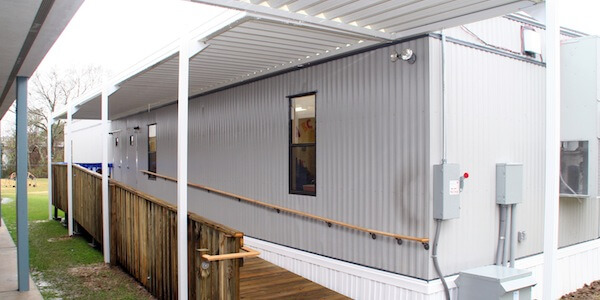Temporary Modular Buildings

Relocatable, prefab, portable, temporary, or “mobile module” – all these words refer to a “modular” building. Modular buildings are
- constructed off-site (in an indoor manufacturing plant),
- made of individual modules (three-dimensional sections), and
- delivered separately to the site and then placed into position to create the structure.
On-site preparation – foundation and utility work – can be completed at the same time that the modules are being constructed at the plant, allowing for faster build time, delivery, and installation.
Why Choose a Temporary Structure?
Temporary modular buildings, mainly constructed from wood, are meant for short-term needs – mostly a few months to a few years (but can last longer) – and can be relocated when no longer needed. Permanent buildings, on the other hand, are normally made of steel, concrete, and wood, meant to last for decades. Permanent modular buildings are set in their foundations; despite this, they can be moved, with extra effort. Users can lease or buy temporary units. Permanent buildings are mostly purchased but there are lease options as well.
How are Temporary Modular Buildings Used?
These temporary buildings can prove beneficial for
- start-up businesses or schools
- schools facing enrollment increases
- temporary programs needing more office space
- relief from natural disasters
- swing space during construction projects or renovation
- man camps and workforce housing
- places of worship (e.g. churches, temples, mosques)
- health care facilities
- government needs
Benefits of Temporary Buildings
- The process is more eco-friendly than on-site building. Construction/assembly generates minimal site disruption, less waste, and fewer environmental pollutants.
- Buildings are ready sooner. Delivery often comes 30 to 50 percent faster, as well as more efficiently, than with conventional building, due to the shorter build time. Occupancy is available in as little as 60 to 90 days, and used buildings can be ready to go in only a few weeks’ time.
- Costs are lower, again due to reduced wait times and greater efficiency.
- Spaces are healthier, because construction takes place in a controlled indoors manufacturing plant environment, protecting the building process from weather extremes. There is less mildew, mold, rust, and weather damage, reducing respiratory problems and keeping materials sound.
- Users have far more flexibility with building life cycles. Buildings can be moved from spot to spot or easily removed when they are no longer needed, or reconfigured with extra sections or whole floors.
The bottom line is that it’s a faster building process using high-quality and sustainable materials. Buildings can be removed, reconfigured, and relocated relatively easily.
Get a Quote for a Temporary Modular Building
When seeking a quote, buyers or renters may be asked for information such as
- personal information
- company information and industry type
- location
- space (square footage) needed
- project description/construction type
- date when you’ll need the product ready
You’ll have the opportunity to lease, lease to purchase, or buy. Temporary modular buildings meet the same building codes as traditional construction, and they are durable yet easy to move. Despite the moniker “temporary,” they can be attractive, efficient, and sturdy. Whether the goal is a temporary or permanent structure, modular buildings are well-known for their cost savings, high quality, and flexibility.
Recent Articles
- Purchasing Options for Mobile Offices: Renting vs. Buying, Used vs. New
- How to Go Green When Choosing a Mobile Office or Classroom Trailer
- Customizing Your Mobile Office: Typical Add-Ons & Amenities
- What to Look for in Moving & Storage Containers
- Four Great Reasons to Choose a Modular Building for Your School
